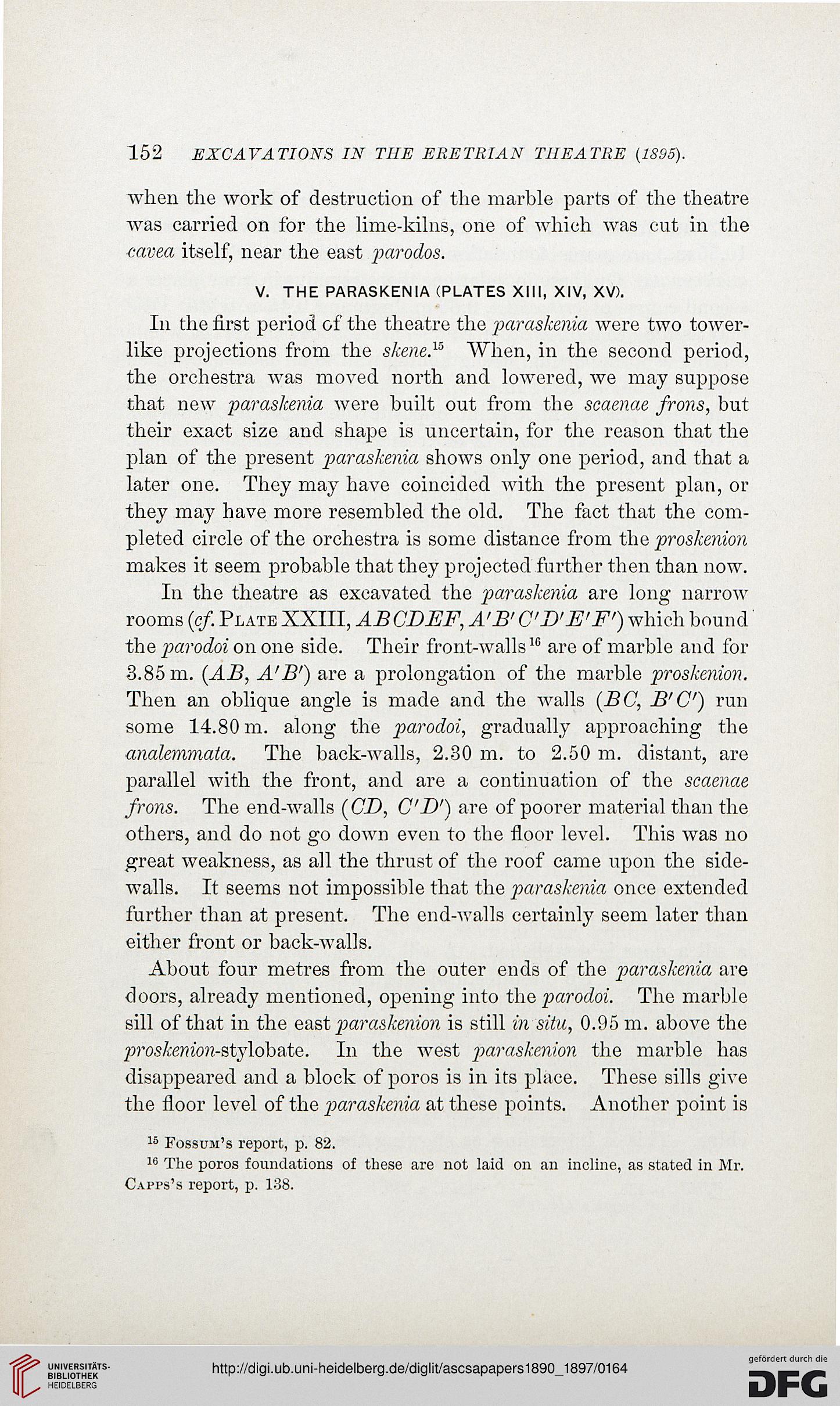152
EXCAVATIONS IN THE ERETEIAN THEATRE (1S95).
when the work of destruction of the marble parts of the theatre
was carried on for the lime-kilns, one of which was cut in the
eavea itself, near the east parodos.
V. THE PARASKENIA (PLATES XIII, XIV, XV).
In the first period of the theatre the paraskenia were two tower-
like projections from the skene.15 When, in the second period,
the orchestra was moved north and lowered, we may suppose
that new paraskenia were built out from the scaenae frons, but
their exact size and shape is uncertain, for the reason that the
plan of the present paraskenia shows only one period, and that a
later one. They may have coincided with the present plan, or
they may have more resembled the old. The fact that the com-
pleted circle of the orchestra is some distance from the proskenion
makes it seem probable that they projected further then than now.
In the theatre as excavated the paraskenia are long narrow
rooms (cf. Plate XXIII, AB CDEF, A'B' C'D'E'F') which bound
the parodoi on one side. Their front-walls16 are of marble and for
3.85 m. (AB, A'B') are a prolongation of the marble proskenion.
Then an oblique angle is made and the walls (BC, B'C) run
some 14.80 m. along the parodoi, gradually approaching the
analemmata. The back-walls, 2.30 m. to 2.50 m. distant, are
parallel with the front, and are a continuation of the scaenae
frons. The end-walls (CD, CD') are of poorer material than the
others, and do not go down even to the floor level. This was no
great weakness, as all the thrust of the roof came upon the side-
walls. It seems not impossible that the paraskenia once extended
further than at present. The end-walls certainly seem later than
either front or back-walls.
About four metres from the outer ends of the paraskenia are
doors, already mentioned, opening into the parodoi. The marble
sill of that in the east paraskenion is still in situ, 0.95 m. above the
proskenion-stylob&te. In the west paraskenion the marble has
disappeared and a block of poros is in its place. These sills give
the floor level of the paraskenia at these points. Another point is
16 Fossum's report, p. 82.
10 The poros foundations of these are not laid on an incline, as stated in Mr.
Capps's report, p. 138.
EXCAVATIONS IN THE ERETEIAN THEATRE (1S95).
when the work of destruction of the marble parts of the theatre
was carried on for the lime-kilns, one of which was cut in the
eavea itself, near the east parodos.
V. THE PARASKENIA (PLATES XIII, XIV, XV).
In the first period of the theatre the paraskenia were two tower-
like projections from the skene.15 When, in the second period,
the orchestra was moved north and lowered, we may suppose
that new paraskenia were built out from the scaenae frons, but
their exact size and shape is uncertain, for the reason that the
plan of the present paraskenia shows only one period, and that a
later one. They may have coincided with the present plan, or
they may have more resembled the old. The fact that the com-
pleted circle of the orchestra is some distance from the proskenion
makes it seem probable that they projected further then than now.
In the theatre as excavated the paraskenia are long narrow
rooms (cf. Plate XXIII, AB CDEF, A'B' C'D'E'F') which bound
the parodoi on one side. Their front-walls16 are of marble and for
3.85 m. (AB, A'B') are a prolongation of the marble proskenion.
Then an oblique angle is made and the walls (BC, B'C) run
some 14.80 m. along the parodoi, gradually approaching the
analemmata. The back-walls, 2.30 m. to 2.50 m. distant, are
parallel with the front, and are a continuation of the scaenae
frons. The end-walls (CD, CD') are of poorer material than the
others, and do not go down even to the floor level. This was no
great weakness, as all the thrust of the roof came upon the side-
walls. It seems not impossible that the paraskenia once extended
further than at present. The end-walls certainly seem later than
either front or back-walls.
About four metres from the outer ends of the paraskenia are
doors, already mentioned, opening into the parodoi. The marble
sill of that in the east paraskenion is still in situ, 0.95 m. above the
proskenion-stylob&te. In the west paraskenion the marble has
disappeared and a block of poros is in its place. These sills give
the floor level of the paraskenia at these points. Another point is
16 Fossum's report, p. 82.
10 The poros foundations of these are not laid on an incline, as stated in Mr.
Capps's report, p. 138.





